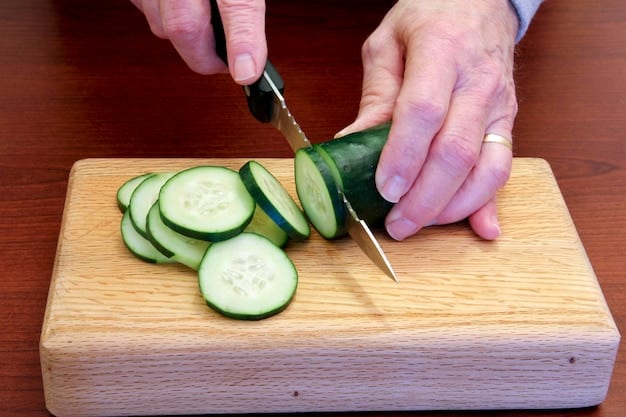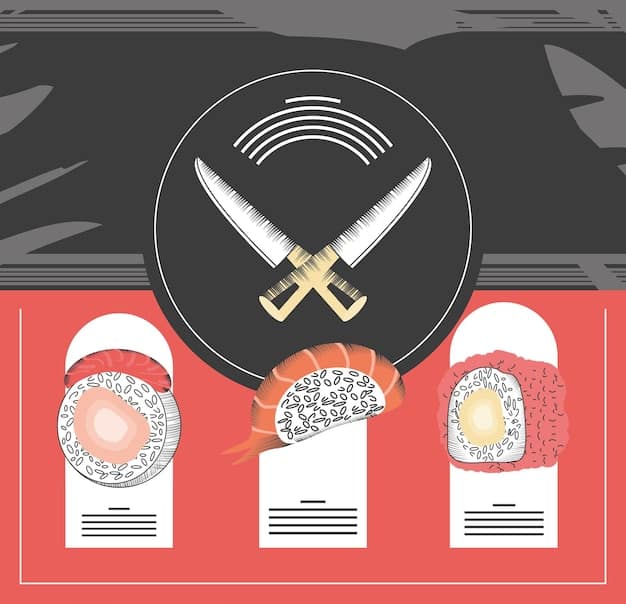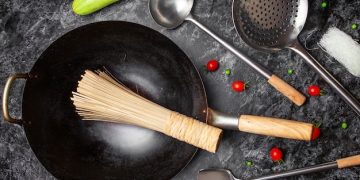Mastering Japanese Knife Skills: A Culinary Excellence Guide

Knife Skills 101: Mastering Japanese Cutting Techniques for Culinary Excellence involves understanding the unique knives and precise methods used in Japanese cuisine, essential for achieving culinary artistry.
Unlock the secrets of precision and elevate your culinary creations with Knife Skills 101: Mastering Japanese Cutting Techniques for Culinary Excellence. This guide provides a comprehensive introduction to the art of Japanese knife work, ensuring you achieve culinary excellence.
Understanding Japanese Knives
Japanese knives are renowned for their sharpness, precision, and craftsmanship. Unlike Western knives, which often feature a bevel on both sides of the blade, many traditional Japanese knives have a single-bevel design, allowing for incredibly thin and precise cuts.
Understanding the different types of Japanese knives and their specific uses is crucial for mastering Japanese cutting techniques.
Types of Japanese Knives
The world of Japanese knives is diverse, with each knife designed for a specific purpose. Here are some of the most essential knives for any aspiring chef:
- Deba: A heavy, thick-bladed knife used for butchering fish and poultry. It’s designed to break down carcasses and separate fillets.
- Usuba: A thin, rectangular-bladed knife primarily used for cutting vegetables. Its flat edge allows for precise, clean cuts.
- Yanagiba: A long, slender knife used for slicing raw fish for sushi and sashimi. Its length allows for drawing the knife through the fish in one smooth motion.
- Santoku: A versatile knife that can handle a variety of tasks, from slicing vegetables to cutting meat. It’s often considered the Japanese equivalent of a chef’s knife.

Each of these knives requires a specific technique to maximize its potential and achieve perfect cuts.
In conclusion, familiarizing yourself with the types of Japanese knives is essential for mastering various cutting techniques. Each knife serves a specific purpose, allowing for precision and efficiency in the kitchen.
Essential Knife Handling Techniques
Proper knife handling is crucial for safety, efficiency, and achieving the desired results. Whether you’re a novice or an experienced cook, mastering these techniques can significantly improve your culinary skills.
Grip, posture, and cutting motion are all important aspects of knife handling. Let’s explore these aspects in detail.
The Correct Grip
The way you hold your knife can greatly affect your control and precision. Here’s how to achieve a proper grip:
- Pinch Grip: Hold the knife with your thumb and index finger pinching the blade just above the bolster (the part where the blade meets the handle). Wrap your remaining fingers around the handle for a secure grip.
- Handle Grip: For heavier tasks that require more power, you can grip the handle firmly with all fingers. However, maintain control to ensure precision.
Posture and Stance
Your posture and stance are just as important as your grip. Here are some tips:
- Stable Base: Stand with your feet shoulder-width apart, one foot slightly forward for balance. This will give you a stable base to work from.
- Elbow Position: Keep your elbows close to your body to maintain control and reduce strain.
Basic Cutting Motions
There are several basic cutting motions that are fundamental to Japanese knife skills:
- Push Cut: A technique where the knife is pushed forward through the ingredient. Ideal for slicing meats and larger vegetables.
- Pull Cut: The knife is pulled back towards you. This method is especially useful for slicing fish for sashimi.
- Rocking Cut: The knife is rocked back and forth, keeping the tip in contact with the cutting board. This is suitable for chopping herbs and mincing vegetables.
Mastering these basic techniques will provide a solid foundation for more advanced cutting styles.
In conclusion, understanding and practicing these essential knife handling techniques will improve your precision and safety in the kitchen. Proper grip, stance, and cutting motions are the building blocks of advanced knife skills.
Mastering the Katsuramuki Technique
The Katsuramuki technique is a classic Japanese cutting method used to create thin, paper-like sheets from vegetables. This technique not only showcases a chef’s skill but also enhances the texture and presentation of dishes.
Katsuramuki requires precision, patience, and a sharp knife. Let’s dive into the details to help master this technique.
Preparing the Vegetable
The first step in mastering Katsuramuki is preparing the vegetable properly:
- Choose the Right Vegetable: Cucumbers, daikon radishes, and carrots are ideal for this technique due to their cylindrical shape.
- Peel the Vegetable: Ensure the vegetable is thoroughly peeled to remove any rough skin.
- Trim the Ends: Cut off the ends to create a flat surface for easy handling.
Executing the Cut
Once the vegetable is prepped, the next step is to execute the cut:
- Hold the Vegetable: Hold the vegetable firmly in one hand, using your fingers to guide the knife.
- Start Peeling: Begin peeling the vegetable in a continuous, spiral motion, maintaining a consistent thickness.
- Maintain Even Pressure: Apply even pressure to the knife to ensure the sheet is uniform.
Tips for Success
Here are some additional tips to help you master the Katsuramuki technique:
* Practicing consistently helps improve the speed and consistency.
* Sharpness is key, so keep your knife properly sharpened.
* Patience is essential, especially when learning.
In conclusion, the Katsuramuki technique is a testament to the artistry of Japanese cuisine. While it requires practice and patience, mastering this technique can elevate your cooking skills and impress diners with elegant presentations.
The Art of Slicing: Sasagiri and Tanzaku
Sasagiri and Tanzaku are two distinct Japanese slicing techniques used to prepare ingredients in specific shapes and sizes. These techniques are essential for creating visually appealing and texturally balanced dishes.
Understanding the purpose and method behind each technique will add depth to your culinary repertoire.
Sasagiri: This technique involves cutting ingredients, typically vegetables, into thin, bamboo leaf shapes. The angled cuts provide an elegant, rustic look. Sasagiri is commonly used for garnishing dishes, adding a touch of nature-inspired beauty.
Tanzaku: This technique involves cutting ingredients into small, rectangular strips. Tanzaku is often used for ingredients that require even cooking, such as stir-fries or soups, ensuring uniform texture and flavor distribution.
Applying the Techniques
Applying Sasagiri and Tanzaku effectively requires attention to detail and precision:
Sasagiri
* Hold the vegetable at an angle.
* Make thin, diagonal slices.
* Maintain consistent slice thickness.
Tanzaku
* Cut the vegetable into even rectangles.
* Stack the rectangles.
* Slice into uniform strips.
In conclusion, Sasagiri and Tanzaku exemplify how Japanese cutting techniques enhance both the aesthetic appeal and functional aspects of cooking. By mastering these techniques, you can add sophistication and balance to your dishes.
Perfecting the Round Cut: Mawashigiri
Mawashigiri, or the “turning cut,” is a technique used to create rounded pieces of vegetables, such as carrots and potatoes. This method is not only visually appealing but also ensures even cooking.
Mastering Mawashigiri involves turning the vegetable while cutting, creating symmetrical rounded shapes. The technique adds elegance to both simple and complex dishes.
Steps for Mawashigiri
Follow these steps to achieve perfect Mawashigiri:
- Prepare the Vegetable: Peel and trim the vegetable into a manageable size.
- Initial Cut: Make an initial vertical cut to create a flat surface.
- Turning Cut: Hold the vegetable firmly and begin cutting around the edge, turning the vegetable slightly with each cut to create a rounded shape.
- Continue Rotating: Continue rotating and cutting until you have a uniformly rounded piece.
Tips for Evenness
* Maintain a consistent knife angle.
* Rotate the vegetable evenly.
* Practice for uniform shapes.
In conclusion, the Mawashigiri technique is an example of how simple cutting methods can significantly enhance the presentation and functionality of a dish. With a bit of practice, you can master this technique and bring a touch of elegance to your cooking.
Maintaining Your Knives: Sharpening and Care
Maintaining your knives is essential for safety, efficiency, and precision. Sharp knives are not only easier to use but also safer because they require less force, reducing the risk of slipping. Proper care and sharpening are crucial for preserving the quality and performance of Japanese knives.
Regular maintenance ensures that your knives remain in optimal condition. Let’s explore the key aspects of knife maintenance.
Sharpening Techniques
* Using a Whetstone:
* Soak the whetstone in water for about 10-15 minutes.
* Hold the knife at the correct angle (usually 15-20 degrees).
* Apply even pressure and stroke the knife across the whetstone.
* Alternate sides and check the sharpness.
* Using a Honing Steel:
* Hold the honing steel vertically.
* Hold the knife at a slight angle.
* Draw the knife down the steel, alternating sides.
* This straightens the blade and keeps it aligned.
Storage and Cleaning
* Storage: Store knives in a knife block, magnetic strip, or sheath.
* Cleaning: Wash knives by hand with warm, soapy water and dry them immediately.
* Avoid Dishwashers: Dishwashers can damage the blade and handle.
In conclusion, by implementing these maintenance practices, you will ensure your knives remain sharp, safe, and ready for any task. Taking the time to care for your knives is an investment in your culinary skills and safety.
| Key Point | Brief Description |
|---|---|
| 🔪 Knife Types | Different knives like Deba, Usuba, Yanagiba, and Santoku are used for specific tasks. |
| 🖐️ Proper Grip | Use pinch or handle grip for control and precision. |
| 🥕 Katsuramuki | Create thin vegetable sheets using a spiral peeling motion. |
| ✨ Sharpening | Maintain knife sharpness with whetstones and honing steels. |
Frequently Asked Questions
▼
The Santoku knife is often recommended for beginners due to its versatility. It can handle a variety of tasks, from slicing vegetables to cutting meat, making it a great all-purpose option.
▼
The frequency of sharpening depends on usage. For regular home use, sharpening every 2-3 months is generally sufficient. Professional chefs may need to sharpen their knives more frequently, even daily.
▼
No, it is generally not recommended to use a dishwasher for Japanese knives. The harsh detergents and high temperatures can damage the blade and handle. Hand washing is the preferred method.
▼
The best way to store Japanese knives is in a knife block, on a magnetic strip, or in sheaths. These methods protect the blade from damage and prevent accidents.
▼
The ideal angle for sharpening a Japanese knife is typically between 15 and 20 degrees. This angle provides a balance of sharpness and durability, suitable for most Japanese knife types.
Conclusion
Mastering Japanese knife skills is a journey that combines technical knowledge with artistic expression. By understanding the unique designs of Japanese knives, practicing essential handling techniques, and maintaining your tools, you can unlock a new level of culinary precision and creativity. Embrace the art and elevate your cooking to new heights.





